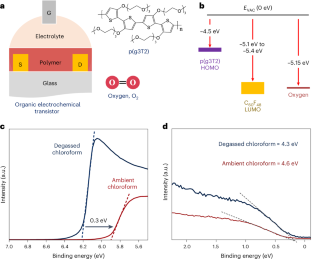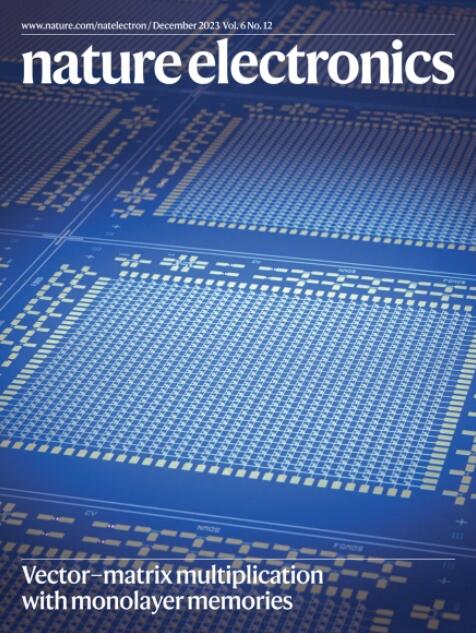Improved organic electrochemical transistor stability using solvent degassing and chemical doping
IF 40.9
1区 工程技术
Q1 ENGINEERING, ELECTRICAL & ELECTRONIC
引用次数: 0
Abstract
Organic mixed ionic–electronic conductors (OMIECs), which can be used to build organic electrochemical transistors (OECTs), are of potential use in flexible, large-area and bioelectronic systems. Although hole-transporting p-type OMIECs are susceptible to oxidation, and oxygen leads to OECT instability, it is unclear whether oxygen also behaves as an uncontrolled p-dopant. We show that oxygen dissolved in a solvent can act as a p-dopant in OMIECs and OECTs by filling traps to enable effective electrochemical doping. To address the fact that the presence of oxygen simultaneously jeopardizes OECT stability, we develop a two-step strategy in which we first degas the solvent, and then dope the OMIEC in a controlled manner using a chemical dopant. Our approach improves the stability of both p-type and n-type OECTs, while increasing the on–off ratio, tuning the threshold voltage and enhancing the transconductance, charge carrier mobility, and the µC* product—that is, the product of mobility and the volumetric capacitance. The stability and performance of organic electrochemical transistors can be improved using a two-step technique in which oxygen is first removed from the solvent and then a chemical dopant is introduced into the organic mixed ionic–electronic conductor.


采用溶剂脱气和化学掺杂提高了有机电化学晶体管的稳定性
有机混合离子电子导体(OMIECs)可用于构建有机电化学晶体管(OECTs),在柔性、大面积和生物电子系统中具有潜在的应用前景。虽然空穴输运p型omiec易氧化,氧气导致OECT不稳定,但尚不清楚氧气是否也表现为不受控制的p掺杂剂。我们发现溶解在溶剂中的氧可以通过填充陷阱在omiec和OECTs中充当p掺杂剂,从而实现有效的电化学掺杂。为了解决氧气同时存在会危及OECT稳定性的问题,我们制定了一个两步策略,首先将溶剂脱气,然后使用化学掺杂剂以受控的方式对OMIEC进行掺杂。我们的方法提高了p型和n型oect的稳定性,同时增加了通-关比,调整了阈值电压,增强了跨导、电荷载流子迁移率和µC*积(即迁移率和体积电容的乘积)。
本文章由计算机程序翻译,如有差异,请以英文原文为准。
求助全文
约1分钟内获得全文
求助全文
来源期刊

Nature Electronics
Engineering-Electrical and Electronic Engineering
CiteScore
47.50
自引率
2.30%
发文量
159
期刊介绍:
Nature Electronics is a comprehensive journal that publishes both fundamental and applied research in the field of electronics. It encompasses a wide range of topics, including the study of new phenomena and devices, the design and construction of electronic circuits, and the practical applications of electronics. In addition, the journal explores the commercial and industrial aspects of electronics research.
The primary focus of Nature Electronics is on the development of technology and its potential impact on society. The journal incorporates the contributions of scientists, engineers, and industry professionals, offering a platform for their research findings. Moreover, Nature Electronics provides insightful commentary, thorough reviews, and analysis of the key issues that shape the field, as well as the technologies that are reshaping society.
Like all journals within the prestigious Nature brand, Nature Electronics upholds the highest standards of quality. It maintains a dedicated team of professional editors and follows a fair and rigorous peer-review process. The journal also ensures impeccable copy-editing and production, enabling swift publication. Additionally, Nature Electronics prides itself on its editorial independence, ensuring unbiased and impartial reporting.
In summary, Nature Electronics is a leading journal that publishes cutting-edge research in electronics. With its multidisciplinary approach and commitment to excellence, the journal serves as a valuable resource for scientists, engineers, and industry professionals seeking to stay at the forefront of advancements in the field.
 求助内容:
求助内容: 应助结果提醒方式:
应助结果提醒方式:


